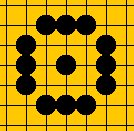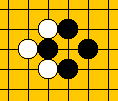User:Evercat/Go rules
|
|
- Note: The final version should definitely be illustrated with diagrams for capture, ko, suicide, life and death, and scoring. Most of the ambiguities or vagueness currently present will be much lessened with appropriate diagrams...
This is a discussion of the rules of Go.
| Contents |
Rules of play
Preliminaries
- Go is a board game for 2 players, called Black and White.
- Each player has an essentially unlimited supply of pieces his colour, called stones.
- The board (illustration) is a grid of 19 horizontal and 19 vertical lines.
- An intersection is a point where a horizontal line meets a vertical line. The board thus has 361 intersections.
Basics of play
- The players alternate. Black starts.
- On his turn, a player makes either a play or a pass.
- When a player makes a play, he puts one stone of his colour on an empty intersection.
- When a player makes a pass, he does nothing. Alternation continues with his opponent.
- The game ends when a player makes a pass and then his opponent immediately makes a pass.
Capture
- One stone, or several stones that are of the same colour and mutually connected via lines of the grid, must be adjacent to at least one empty intersection, which is called a liberty. If a play leaves any opposing stones without liberties, those opposing stones are captured and removed from the board as prisoners.
Suicide
- A player's play is prohibited if it leaves stones of his without liberties after any removal of opposing stones.
Black cannot play at the triangle. |
Black can play here, as his stone has liberties after the removal of captured White stones. |
Ko (prohibition of repetition)
- In a ko position (illustrated below), a player whose stone has been captured in the ko cannot recapture in that ko on the next move.
The ko rule prevents this position repeating forever. |
Scoring
Once the game is over, there are 2 fundamental ways of scoring the game and thus determining the result. These is "territory scoring" (used by the common Japanese rules) and "area scoring" (used by most other rulesets). Which scoring method is to be used should be agreed before the game starts.
Territory scoring
To understand territory rules, it is helpful to understand the concept of life and death:
- A group is dead if the opponent could (under best play) capture it by filling in all its liberties.
- A group is alive if it has, or can make, two permanent liberties (known as two eyes). Since the opponent could never fill both eyes at once, such a group cannot be captured.
- A group is alive in seki if the opponent cannot fill its liberties without exposing his own group to capture.
| A group with two eyes. | This black group does not have two eyes. White kills it by playing inside it. |
Seki. Neither side will play at the triangle - capture would follow. |
This relates to scoring as follows:
- Under territory scoring, dead stones are removed as prisoners after the end of the game, and a player's score is the sum of empty intersections completely enclosed by his stones (this is called his territory), plus the number of enemy stones he has captured.
Area scoring
- Under area scoring, a player's score is the sum of his stones on the board, plus empty intersections (territory) completely enclosed by his stones. To hasten the game's end, dead stones are removed as in territory scoring however, under area scoring the opponent could actually capture them during the game itself, without affecting his score (whereas in territory rules this is impossible).
Discussion of the scoring rules
If both players make the same number of plays, the result should be the same, due to the fact that the difference in the number of prisoners will equal the difference in the number of stones on the board, while the size of the players' territories is the same under any way of counting.
Under territory scoring, a player cannot actually capture dead enemy stones inside his territory without affecting his score, since to do so would involve playing stones in his own territory, thus reducing its size. At the end of a game played with area scoring, such moves to capture are perfectly safe.
Komi
To compensate White for having to play second, he receives a certain number of points which are added to his score at the end. This is called a komi. Komi may be zero, or an integer such as 6, or a decimal value such as 6.5, in which case draws are impossible, as White will always win or lose by at least half a point.
Handicap
In games between players of unequal strength, a handicap is given, where the weaker player takes the black stones, and is allowed to make a certain number of moves before White's first move.
Depending on the ruleset, Black's handicap stones either must be placed on the board's star points in a certain order, or may be played freely anywhere. The first type of handicap (fixed handicap) is more common.
Other ruleset variations
- The basic ko rule only prevents cycles where each side is capturing and recapturing a single stone. There are other (very rare) situations in which longer cycles of repetition may occur. To prevent this, some (rarely used) rulesets use a rule called superko which explicitly prohibits any play that would recreate any previous board position.
- Although most rulesets prohibit suicide, it is possible to dispense with this rule. In most cases suicide is merely a blunder, but there are a few occasions where it is helpful.






